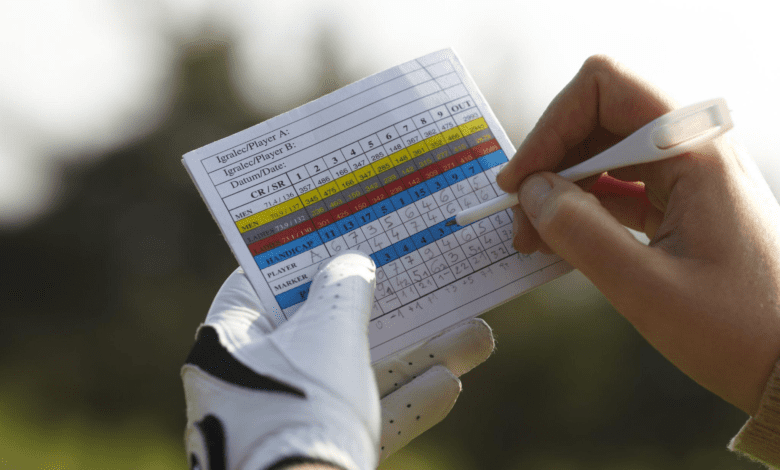How to Calculate Golf Handicap: Understanding the System

Introduction:
A golf handicap is a measure of a golfer’s skill level, allowing players of different abilities to compete on an equal footing. Understanding how to calculate a golf handicap is essential for both casual and competitive golfers. This article provides a comprehensive guide to help you understand the golf handicap system and how to calculate your handicap accurately.

1. What is a Golf Handicap?
A golf handicap is a numerical representation of a golfer’s potential ability. It allows players of different skill levels to compete fairly by adjusting the number of strokes they receive on each hole.
2. How is a Golf Handicap Calculated?
The golf handicap calculation takes into account the slope rating and course rating of the golf course being played, as well as the player’s scores from previous rounds. The calculation involves several steps to determine an accurate handicap index.
3. Establishing a Handicap Index
Establishing a handicap index is a crucial step in calculating a golfer’s handicap. The handicap index is a numerical representation of a golfer’s potential ability and serves as the foundation for determining the course handicap for different golf courses. Here’s an explanation of how to establish a handicap index:
- Submitting Scores: To establish a handicap index, golfers need to submit scores from a minimum number of rounds, usually around 5-10, to their local golf association or club. These scores should be from designated golf courses that are eligible for handicap purposes.
- Score Differential Calculation: The submitted scores are used to calculate the score differentials. A score differential is the difference between a player’s adjusted gross score and the course rating, adjusted for slope rating and other factors. Each score differential represents the player’s performance in a particular round.
- Selecting Best Differentials: The handicap calculation system considers the best differentials from the submitted scores. The number of differentials used depends on the local golf association’s guidelines. Typically, the best differentials from the most recent 20 rounds are considered, with a sliding scale that gives more weight to the most recent scores.
- Calculation Formula: The handicap index calculation formula involves taking the average of the best differentials, multiplying it by 0.96 (to adjust for statistical outliers), and rounding the result to one decimal place. The resulting value is the golfer’s handicap index.
- Revising the Handicap Index: As golfers play more rounds and submit new scores, their handicap index is revised regularly. The system considers the most recent differentials and updates the handicap index to reflect the golfer’s current playing ability.
By establishing a handicap index, golfers have a standardized measure of their potential ability. This allows them to compete on an equal footing with other golfers and provides a fair way to adjust the number of strokes they receive on different courses. It’s important to follow the guidelines and procedures set by the local golf association or club to ensure the accuracy and validity of the handicap index.
- NASCAR’s Coke Zero Sugar 400 features massive wreck; Ryan Blaney crashes hard into wall
- Viktor Hovland takes six-shot lead into Sunday’s final round
- Jones explains Cowboys’ mindset in trading for ‘young talent’ Lance
- Vicious 16-car wreck ends the second stage at Daytona
- Angels rookie Chase Silseth exits game after collapsing from throw to head
4. Calculating Course Handicap
Once you have your handicap index, you can calculate your course handicap for a specific golf course. The course handicap adjusts your handicap index based on the difficulty of the course being played.
5. Understanding Slope Rating
Slope rating is a measure of the relative difficulty of a golf course for bogey golfers compared to scratch golfers. It is used in the handicap calculation to adjust a player’s handicap based on the course’s difficulty.
6. Course Rating and Par
Course rating represents the expected score of a scratch golfer on a particular course. It is used in conjunction with slope rating to determine the course handicap.
7. Applying Handicap Strokes
To apply handicap strokes during a round, consult the handicap allocation table provided by the golf course or organization. The table indicates the number of strokes a player receives on each hole based on their course handicap.
8. Adjusting for Playing Conditions
Adjusting playing conditions is an essential aspect of calculating a golfer’s handicap to ensure fairness and accuracy in different situations. Playing conditions such as course difficulty, weather conditions, and tee selection can significantly impact a golfer’s performance. Here’s an explanation of how adjustments are made to account for playing conditions:
- Course Rating and Slope Rating: Golf courses are rated based on their difficulty for scratch golfers (those with a handicap index of 0). The course rating represents the expected score a scratch golfer would achieve on the course. Additionally, courses are assigned a slope rating, which reflects the relative difficulty of the course for golfers with different skill levels.
- Playing Conditions Calculation: When golfers submit their scores for handicap purposes, the playing conditions are taken into account. The USGA (United States Golf Association) provides guidelines on how to adjust scores based on playing conditions. For example, if the course is playing particularly challenging due to factors like strong wind or wet conditions, the scores may be adjusted to reflect the increased difficulty.
- Playing Conditions Calculation Formula: The adjustment for playing conditions is typically calculated using a formula that considers the difference between the course rating and the player’s handicap index, as well as the slope rating of the course. The formula may vary depending on the specific handicap calculation system used in a particular region.
- Daily Handicap Calculation: The adjustment for playing conditions results in a daily handicap. The daily handicap is the number of strokes a player receives on a specific day or for a specific round, based on the course difficulty and the player’s handicap index. It allows for equitable competition among players of varying abilities on different courses and under different conditions.
By making adjustments for playing conditions, golfers can level the playing field and ensure that their handicap accurately reflects their performance relative to the difficulty of the course and prevailing conditions. It helps to create fair and competitive opportunities for golfers of all skill levels. Golf associations and clubs typically provide guidelines on how to calculate the adjustments, and it’s important for golfers to follow these guidelines to maintain the integrity of the handicap system.
9. Updating the Handicap Index
Your handicap index should be updated regularly to reflect your current playing ability. Submit new scores after each round to ensure your handicap remains accurate.
10. Competition Handicap
For competitive play, a player’s handicap may be further adjusted to establish a competition handicap, which accounts for the specific conditions of the event or tournament.
11. The World Handicap System
In recent years, many golf associations have adopted the World Handicap System (WHS), which provides a unified handicap system globally. Familiarize yourself with the specific rules and guidelines of the WHS if it applies to your golf association.
12. Seek Guidance from Golf Professionals
Seeking guidance from golf professionals is a valuable step for golfers looking to improve their skills and understanding of the game. Golf professionals, such as certified instructors or PGA (Professional Golfers’ Association) professionals, have extensive knowledge and experience in all aspects of the game. Here’s an explanation of how seeking guidance from golf professionals can benefit golfers:
- Swing Technique: Golf professionals are experts in analyzing and improving swing techniques. They can assess your current swing, identify areas for improvement, and provide guidance on proper form, alignment, grip, and posture. Working with a professional can help you develop a more consistent and efficient swing, leading to better ball striking and accuracy.
- Game Strategy: Golf professionals can offer valuable insights and strategies for course management. They can help you understand how to approach different holes, make strategic club selections, and navigate challenging course conditions. Their knowledge of course design, hazards, and shot selection can enhance your decision-making on the course and improve your overall scores.
- Short Game Skills: The short game, including putting, chipping, and pitching, is often where golfers can make significant improvements to their scores. Golf professionals can provide specialized instruction on techniques, practice drills, and strategies for improving your short game skills. Their guidance can help you become more confident and precise around the greens.
- Equipment Selection: Golf professionals can assist you in selecting the right equipment for your game. They can analyze your swing characteristics, body type, and skill level to recommend suitable clubs, shaft flex, and other equipment adjustments. Having properly fitted clubs can enhance your performance and optimize your potential.
- Mental Approach: Golf professionals understand the importance of the mental aspect of the game. They can teach you techniques to manage your emotions, stay focused, and develop a positive mindset on the course. Mental coaching can help you handle pressure situations, maintain consistency, and perform at your best.
- Practice Routines: Golf professionals can guide you in creating effective practice routines tailored to your specific needs and goals. They can provide drills, exercises, and training plans to help you make the most of your practice time and maximize improvement.
- Rules and Etiquette: Golf professionals are well-versed in the rules and etiquette of the game. They can educate you on proper golf etiquette, including pace of play, golf course etiquette, and rules of golf. Understanding and following these guidelines contribute to an enjoyable and respectful golfing experience.
Seeking guidance from golf professionals offers personalized instruction, feedback, and support to help you enhance your skills and enjoyment of the game. Whether you’re a beginner or an experienced golfer, working with a professional can accelerate your progress and provide valuable insights that may not be easily discovered on your own.
Conclusion:
Calculating a golf handicap is essential for fair competition and tracking your progress as a golfer. By understanding the golf handicap system, establishing a handicap index, and calculating course handicaps, you can participate in games and tournaments confidently. Remember to stay updated with any rule changes or adaptations to the handicap system and seek guidance from professionals when needed. With a reliable handicap, you can enjoy the game of golf to its fullest and compete on a level playing field with other golfers of varying skill levels.
Also Read-
How to Read Golf Course Layouts: Strategies for Course Management
10 Basketball Shooting Drills: Take Your Shot and Become a Legend on the Court!
How to Fix Common Golf Swing Problems: Techniques and Drills




